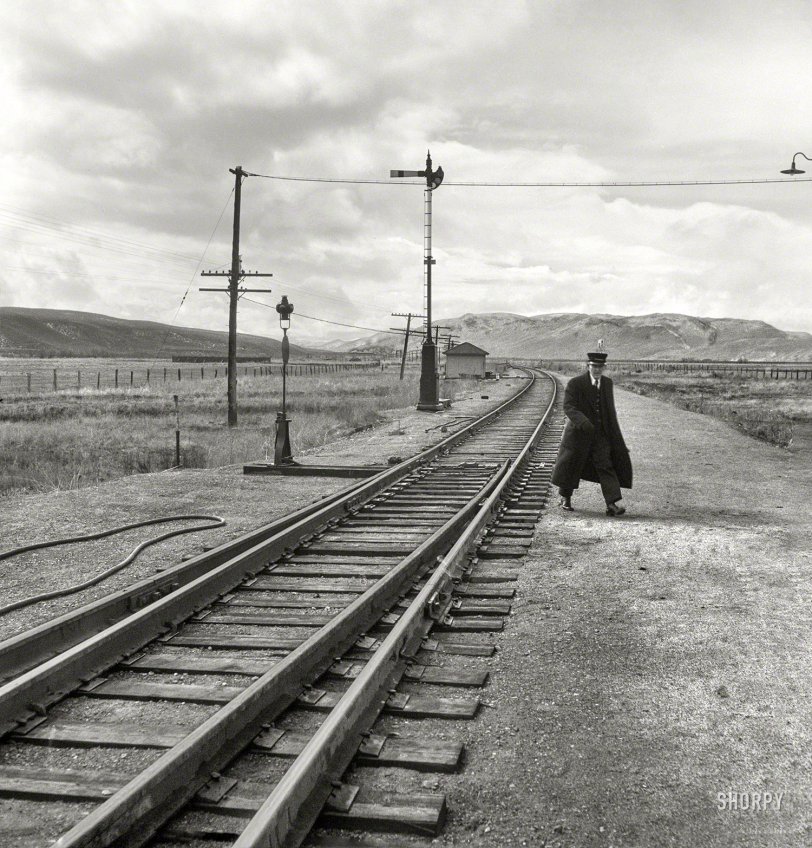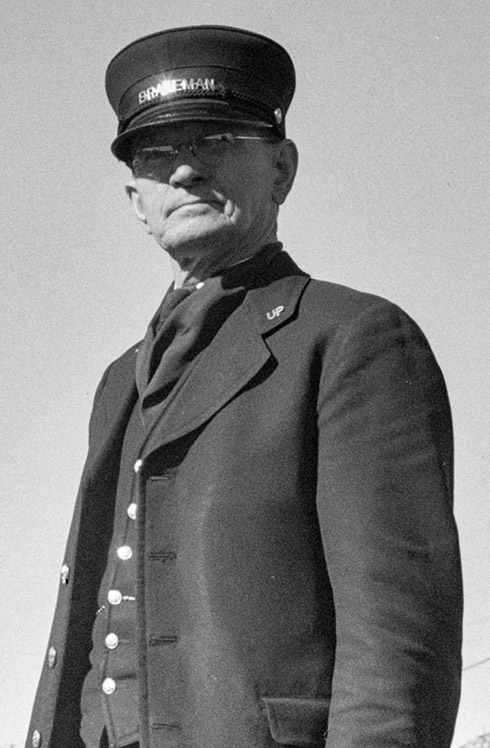


Framed or unframed, desk size to sofa size, printed by us in Arizona and Alabama since 2007. Explore now.
Shorpy is funded by you. Patreon contributors get an ad-free experience.
Learn more.

- Ticket Retention
- Killed by Amtrak
- Back to the Future
- Heckuva remote control!
- Sometimes — Things Go Bump!
- I SEE THE LIGHT
- Union Switch and Signal Company
- Get That Light Out Of My Eyes
- Eggs. Eggs. Eggs. The Egg Man is Here!
- Foreboding caption
- Famous Hollywood faces
- Not just S&P
- re: Those things in the jar
- Up In Smoke
- Medical Smoking
- Quick fix
- A Quink Comment
- If You’re Like Me, Never
- Delivering the News
- U.S.A.
- S&P
- 1940 Zenith radio model 6G601
- Quality goes in before the name goes on!
- Snazzy skirt
- Carbon Arc Lamps
- Illuminate us
- I remember it well
- I can't prove it
- Complicated then, forgotten now
- Bryan-Stevenson
Print Emporium
Brakeman in Black: 1939

June 1939. Carlin, Nevada. "Brakeman on the Union Pacific Challenger." Photo by Dorothea Lange for the Farm Security Administration. View full size.
Passenger Train Conductor
Part of a passenger train conductor's job was to be a brakeman. That job included "lining a route" for the train he was assigned to.
The conductor in the picture is part of the train crew assigned to the "Challenger", a named train on the Union Pacific Railroad.
A brakeman on a freight train would not be wearing a uniform like the one in the picture.
[Their caps say BRAKEMAN. - Dave]

Western Pacific
Camera is looking SW, but the curve is the one at 40.71047N 116.107W, on the Western Pacific. In June 1939 train 88 was due out of Carlin at 1143 PST. The sign down there likely says West Carlin One Mile.
Brakeman
My uncle, who was a conductor on freight trains, said there were many accidents with the loss of limb as well as life. He would relate that in the station house you could see limbs laid against the wall when the injured were brought in. As a conductor, he would walk the roofs of the cars in all kinds of weather conditions and set the brakes on the cars individually as well as the brakeman. He was employed by the Pennsylvania RR for 49 years and had the run from Pittsburgh to Oil City, PA.
Does he have all his fingers?
A brakeman's job was historically very dangerous with numerous reports of brakemen falling from trains, or being run over or crushed by rolling stock. As rail transport technology has improved, a brakeman's duties have been reduced and altered to match the updated technology, and the brakeman's job has become much safer than it was in the early days of railroading. Individually operated car brakes were replaced by remotely-operated air brakes, eliminating the need for the brakeman to walk atop a moving train to set the brakes. Link and pin couplings were replaced with automatic couplings,and hand signals are now supplemented by two-way radio communication.
40.709083N, 116.117243W -- looking SW
In 1939 Dor0thea Lange apparently, like Arthur Rothstein, drove across Nevada along the Lincoln Highway (now Interstate 80) taking pictures. In the town of Carlin, where B Street crosses the railroad tracks going south to West Main Street seems like it might have been the location where this particular image was photographed -- her camera pointed roughly southwest. A second train track now runs alongside. I wonder if the base of the tall old signal tower is the white electrical box there now.
























On Shorpy:
Today’s Top 5